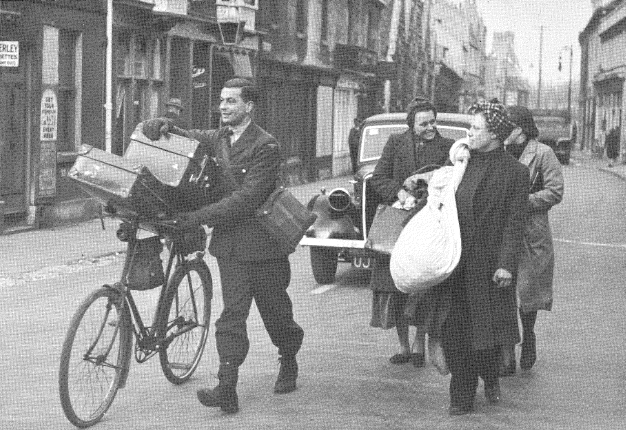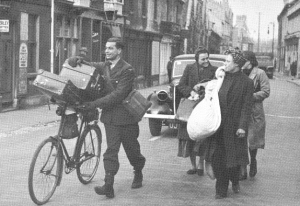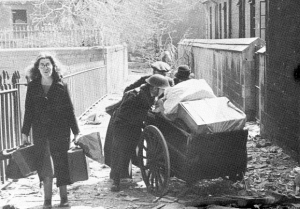
David Symington writes about the Bath Trekkers
March 11, 2013Dr Diamond’s description of refugees fleeing from the northern departments of France, and Paris, in the face of the German advance of 1940 had echoes in Britain when cities were bombed later in the war.
As well as official evacuees, residents would often take to the roads with possessions piled on carts to escape further bombing. Bath was bombed in three raids over two nights on 25th and 26th April 1942, part of the Baedecker series of raids on Britain.
In his book The Bombing of Bath Niall Rothnie wrote:
“One woman remembers seeing people in the streets with prams, carts and other modes of transport filled with the odd possession. Two children walked through the city pushing a tin bath containing just a broken doll.
For one girl, the worst sight was the large number of people leaving the city. Unending streams poured from the town. Many were absolutely silent. They appeared stunned and incapable, at times, of realising where they were. Some carried bundles or pushed prams containing all they had left. A second, consecutive night of raids proved the final straw for many people. Once again the local authorities gave some assistance and provided extra buses , although there were never quite enough. Large queues built up at Parade Gardens.” (pg. 111)
He describes a family which “drove out of the city and into the fields, where the whole party spent a very cold night. It is impossible to say how many trekked out on the second night, but it was certainly far more than on the Sunday evening.”
“Edward and Winifred Hurford walked out to Hampton Rocks with hundreds of others although they didn’t sleep because it was so cold. Mrs Potter and her family also left: ‘After the two terrible nights of the Bath Blitz….we packed a case and our parents took us up to Hampton Rocks. Crowds of people were flocking there for the night. We left our old grandma at home as, being stone deaf and bedridden, she didn’t even know there was a war on!’
“Some had, originally, no intention of leaving but later changed their minds: ‘People started collecting their belongings and leaving until it was eventually it was just three of our families that would be left in the street. Therefore, we packed up our bedding, strapped it on our backs, and walked up past Englishcombe and settled down in the rows along the lane, on the grass verge on the side. It was moonlight and we had to keep our faces covered in case the German bombers saw us and machine-gunned us.’ ” (pg 113)
In his book The Bath Blitz Martin Wainwright described the effects on a village just south of Bath:
“Wellow was untouched but its help was now required in coping with refugees from the blitzed city…Everyone who could had been asked to leave Bath by nine pm in the expectation of a third raid and by nightfall 150 men, women and children had arrived in Wellow. Many were exhausted after spending the previous night in the open, under hedges or in woods…” (pg 62)
In her book Stories of Bath Diana White wrote that after the first night’s raid: “Families in Bathwick, already housing evacuees, found themselves taking in people from Oldfield Park or Bear Flat, both densely populated residential areas that had come in for extensive bombing. Not everyone wanted to risk remaining in the city, however. Buses crammed with people drove up into the fields above Bath and there was a mass exodus of people pushing carts, prams and wheelbarrows filled with their possessions. No-one who watched this procession would ever forget it.” (pg 110)
Thank you to David, and also Martin Wainwright of bathblitz.blogspot.co.uk
All photos courtesy of Martin Wainwright and were originally printed in his book The Bath Blitz. 1992, DK Printing, Bath
References:
Rothnie, N. The Bombing of Bath (1983) Ashgrove Press Ltd, Bath.
Wainwright, M. The Bath Blitz (50th Anniversary Edition 1992) DK Printing, Bath.
White, D. Stories of Bath (2006) Millstream Books, Bath.

